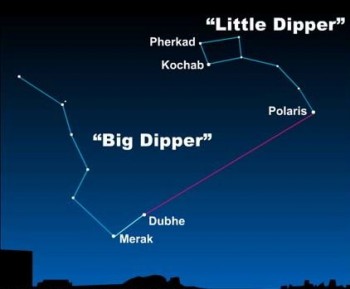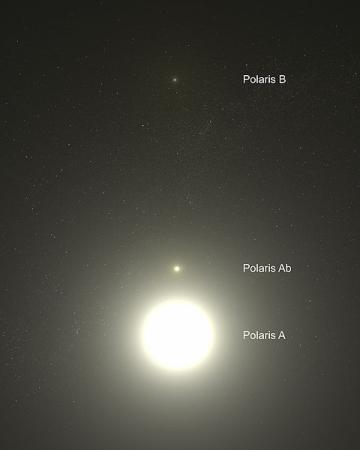 |
Canku Ota
|
 |
|
(Many Paths)
|
||
|
An Online Newsletter
Celebrating Native America
|
||
|
January 2016 - Volume
14 Number 1
|
||
|
|
||
|
Polaris is the North
Star
|
||
|
by Bruce McClure - EarthSky
Tonight
|
||
|
The entire northern sky wheels around Polaris. Some assume it’s the brightest star in the sky. In fact, Polaris ranks only 50th in brightness. The North Star or Pole Star – aka Polaris – is famous for holding nearly still in our sky while the entire northern sky moves around it. That’s because it’s located nearly at the north celestial pole, the point around which the entire northern sky turns. Polaris marks the way due north. As you face Polaris and stretch your arms sideways, your right hand points due east, and your left hand points due west. About-face of Polaris steers you due south. Polaris is not the brightest star in the nighttime sky, as is commonly believed. It’s only about 50th brightest. But you can find it easily, and, once you do, you’ll see it shining in the northern sky every night, from N. Hemisphere locations. Follow the links below to learn more about Polaris.
How to see Polaris. This star is bright enough to spot even from some suburban skies. In a dark country sky, even when the full moon obscures a good deal of the starry heavens, the North Star is relatively easy to see. That fact has made this star a boon to travelers throughout the Northern Hemisphere, both over land and sea. Finding Polaris means you know the direction north. Best of all, Polaris is readily found by using the prominent group of stars known as the Big Dipper, called the Plough in the UK, which may be the Northern Hemisphere’s most famous star pattern. To locate Polaris, all you have to do is to find the Big Dipper pointer stars Dubhe and Merak. These two stars outline the outer part of the Big Dipper’s bowl. Simply draw a line from Merak through Dubhe, and go about 5 times the Merak/Dubhe distance to Polaris. The Big Dipper, like a great big hour hand, goes full circle around Polaris in one day. More specifically, the Big Dipper circles Polaris in a counter-clockwise direction in 23 hours and 56 minutes. Although the Big Dipper travels around Polaris all night long, the Big Dipper pointer stars always point to Polaris on any day of the year, and at any time of the night. Polaris marks the center of Nature’s grandest celestial clock! By the way, Polaris is famous for more reasons than one. It’s famous for hardly moving while the other stars wheel around it. And it’s famous for marking the end of the Little Dipper‘s handle. The Little Dipper is tougher to spot in the night sky than the Big Dipper. But if you use the Big Dipper’s pointer stars to locate Polaris, you’ll be one step closer to seeing the Little Dipper. As you travel northward, Polaris climbs higher in the sky. If you go as far north as the North Pole, you’ll see Polaris directly overhead. As you travel south, Polaris drops closer to the northern horizon. If you get as far as the equator, Polaris sinks to the horizon. South of the equator, Polaris drops out of the sky.
History of Polaris. Polaris hasn’t always been the North Star and won’t remain the North Star forever. For example, a famous star called Thuban, in the constellation Draco the Dragon, was the North Star when the Egyptians built the pyramids. But our present Polaris is a good North Star because it’s the sky’s 50th brightest star. So it’s noticeable in the sky. It served well as the North Star, for example, when the Europeans first sailed across the Atlantic over five centuries ago. And Polaris will continue its reign as the North Star for many centuries to come. It will align most closely with the north celestial pole – the point in the sky directly above Earth’s north rotational axis – on March 24, 2100. The computational wizard Jean Meeus figures Polaris will be 27’09” (0.4525o) from the north celestial pole at that time (a little less than the angular diameter of the moon when at its farthest from Earth). Meanwhile, there is no visible star marking the celestial pole in the Southern Hemisphere. What’s more, the Southern Hemisphere won’t see a pole star appreciably close to the south celestial pole for another 2,000 years. At one time in human history, people literally depended on their lucky stars for their lives and livelihood. Luckily, they could trust the Big Dipper and the North Star to guide them. People could sail the seas and cross the trackless deserts without getting lost. When slavery existed in the United States, slaves counted on the Big Dipper (which they called the Drinking Gourd) to show them the North Star, lighting their way to the free states and Canada. While being honored as the North Star, Polaris enjoys the title
of Lodestar and Cynosure as well.
Polaris science. The single point of light that we see as Polaris is actually a triple star system, or three stars orbiting a common center of mass. The primary star, Polaris A, is a supergiant with about six times the mass of our sun. A close companion, Polaris Ab, orbits 2 billion miles from Polaris. Much farther away, near the top of the illustration at right, is the third companion Polaris B. Polaris B is located approximately 240 billion miles from Polaris A. The two companion stars are the same temperature as Polaris A, but are dwarf stars. Astronomers estimate Polaris’ distance at 430 light-years. Considering the distance, Polaris must be a respectably luminous star. According to the star aficianado, Jim Kaler, Polaris is a yellow supergiant star shining with the luminosity of 2500 suns. Polaris is also the closest and brightest Cepheid variable star – a type of star that astronomers use to figure distances to star clusters and galaxies. Polaris’ position is RA: 2h 31m 48.7s, dec: +89° 15' 51?
|
||||||
|
|
||
|
|
||
| Canku Ota is a free Newsletter celebrating Native America, its traditions and accomplishments . We do not provide subscriber or visitor names to anyone. Some articles presented in Canku Ota may contain copyright material. We have received appropriate permissions for republishing any articles. Material appearing here is distributed without profit or monetary gain to those who have expressed an interest. This is in accordance with Title 17 U.S.C. Section 107. | ||
|
Canku Ota is a copyright ©
2000 - 2015 of Vicki Williams Barry and Paul Barry.
|
||
 |
 |
|
|
The "Canku
Ota - A Newsletter Celebrating Native America" web site and
its design is the
|
||
|
Copyright ©
1999 - 2015 of Paul C. Barry.
|
||
|
All Rights Reserved.
|
||


